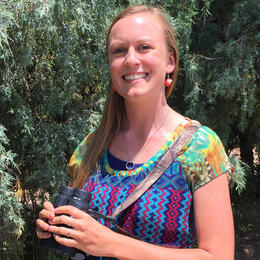Grasslands in North America face many threats. Less than 40% of historical grasslands remain and the majority of those acres are fragmented or degraded due to various human land use changes. With the loss of grasslands comes the loss of grassland birds – they are among the most imperiled groups of birds in the United States, with some iconic species such as the Lesser Prairie-chicken hovering at the brink of extinction.
Grassland conservation is challenging, especially on private lands where decisions are made largely at the discretion of individual landowners and ranch managers. Even on federal or state-owned public lands, bird habitat conservation is only one consideration that must be weighed against other interests including energy development, livestock grazing, hunting, and general public use.
To combat the negative effects of grassland degradations—and to keep grass on the landscape—Audubon has developed the Conservation Ranching Initiative. This market-based conservation approach offers incentives for good grassland stewardship through a certification label on beef products. For the first time, consumers can contribute to grassland conservation efforts by selectively purchasing beef from Audubon-certified farms and ranches. Certified ranches commit to raising grass-fed cattle, never exposed to feedlots, hormones, antibiotic use or neonicotinoid pesticides.
In order to become certified, ranches must show that their livestock management system provides a benefit to grassland birds. A habitat management plan is written for each ranch and certified through a third-party verification process. Additionally, each ranch is given a “Bird Friendliness Index” that measures the abundance, diversity, and resilience of the bird community on certified ranches and compares these metrics to conventionally managed lands. The Bird Friendliness Index tells us that Audubon Conservation Ranching works and that the benefits are measureable. Grassland bird abundance on enrolled ranches is, on average, 36 percent higher than on nearby non-enrolled ranches - meaning that vulnerable species are finding food and shelter on these landscapes.
Keeping grass on the landscape has other ecological benefits as well. Deep-rooted native grasses sequester carbon in the soil, locking carbon below ground and combating the presence of excess greenhouse gasses in the atmosphere. Native grasses and forbs protect fragile and highly erodable soils from wind and water erosion, allowing more water to infiltrate into the soil and be used by plants instead of being lost to surface runoff. These natural ecological processes work together to form healthy soils, which allow plants to reach maximum productivity without the need of herbicides, pesticides, added nutrients, or other chemicals.
Grasslands in New Mexico and Arizona are particularly sensitive to the effects of poor rangeland management. In the southwest, livestock grazing has been linked with population declines of a number of native species. Arid lands and desert grasslands generally have low annual rainfall and thin, fragile soils which means that these landscapes take longer to recover once damaged. Because of the unique ecology of this region, livestock grazing must be carefully implemented to ensure that grazing operations are having a positive rather than negative impact not only on bird populations, but on overall ecosystem health and resiliency. Although arid lands can be challenging to manage properly, these areas provide opportunities to restore native habitat and grassland bird populations. Audubon Southwest is working to expand the Conservation Ranching program into New Mexico and Arizona by partnering with conservation-minded landowners who believe good land stewardship that benefits birds is also the best way to manage their livestock operation.
Learn more about Audubon's Conservation Ranching Initiative here.





